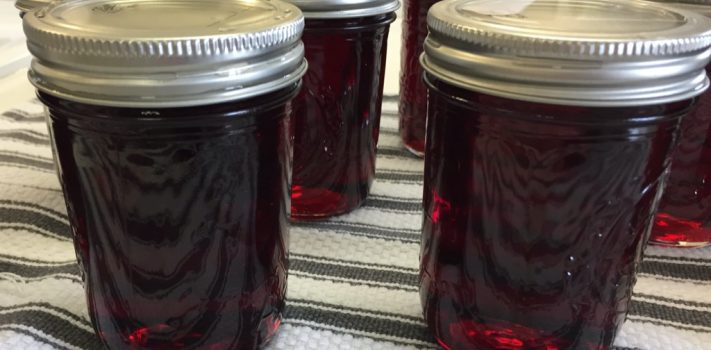The following recipe for Jam or Syrup is from SurvivalBlog reader Mrs. Alaska. She writes:
Fruit jams and syrups are the taste of summer in a jar.
Some jam recipes can sound intimidating, but with only two ingredients, you can make jam. If it does not gel, then you have fruit syrup. What is the downside? Give it a try.
Jam requires a bit of patience and attention (low boiling and stirring over 30 minutes or so) and two, three, or four ingredients depending on the fruit. The easiest fruits have natural pectin ( a jelly-like substance) and acid (sourness) and just require sugar. That’s it! Examples of easy, common, jam-making fruit include all citrus, grapes, blackberries, black currants, and, believe it or not, tart apples. Slightly under-ripe, (tart) fruits are almost foolproof. Other fruits, like stone fruits (peaches, apricots) and strawberries need extra acid (usually lemon juice) and purchased packages of pectin (in the baking aisle). They are NOT 2 ingredient jams.
SO: The easiest jam for first-time jam makers is from tart, high-pectin fruits. Try those above or research the term to find the fruits you favor. (Search “high pectin fruit”)
The first jam I make each year is with haskaps, which are a berry from Japan that I grow in Alaska. Its taste is between a blackberry and a concord grape. It has a blue skin and red interior, in a knobby shape like the end of one’s pinkie finger. This berry also has a high pectin content, which is the jelly-like substance one sees in all citrus, grapes, and some berries.
I dump a gallon of berries into a big pot with ½ a gallon of sugar, and stir often over a medium low flame until the mixture liquefies and thickens. Many recipes recommend a 1:1 ratio of fruit to sweet, which may make sense with citrus and tart apples but this is too sweet for haskaps and my taste in general. I encourage new jammers to start with an existing recipe or cut back on the sugar and then taste and adjust to your preference.
Turning fruit juice into jam involves a chemical reaction of the sugar and acid molecules to bind and thicken. High amounts of sugar or purchased pectin is an easy way to accomplish this, but for my taste, I prefer to simply boil my batch longer, thereby concentrating the flavor as some of the liquid steams off. How long? About 30 minutes, depending on how much liquid is in your fruit of choice. My fruit mixture sheds water, dropping about two inches deeper than its upper line. You will know that that your fruit liquid will gel when the liquid looks glossy. First timers: You can measure temperature. You want about 110 degrees.
BEWARE: As the liquid heats, it will foam up. If you have too small a pot, then you will have a hot, sticky mess on your hands. So make sure that you have about 5 inches of space above your mixture, and keep an eye on the stove, stirring frequently, at a low boil.
When you are finished cooking, pour your hot mixture into hot, clean jars and either pressure can to make them shelf stable, or let them cool and store them in the freezer, long term or refrigerator short term. Label them frozen, refrigerated or canned for future notice.
NOTE: If your first batch does not gel, then do not despair! You have instead created a delicious fruit syrup for pancakes, ice cream, fruit salad, or anything else you wish. Next time, review what you did and revise. You can cook it longer or add citric acid — usually in the form of lemon juice, or more closely monitor the temperature. Either way, you have preserved the taste of summer in a jar. Rejoice and enjoy.
—
Mrs. Alaska blogs at: Alaskauu1.blogspot.com
—
Do you have a well-tested recipe that would be of interest to SurvivalBlog readers? In this weekly recipe column, we place emphasis on recipes that use long-term storage foods, recipes for wild game, dutch oven recipes, slow cooker recipes, and any recipes that use home garden produce. If you have any favorite recipes, then please send them via e-mail. Thanks!










